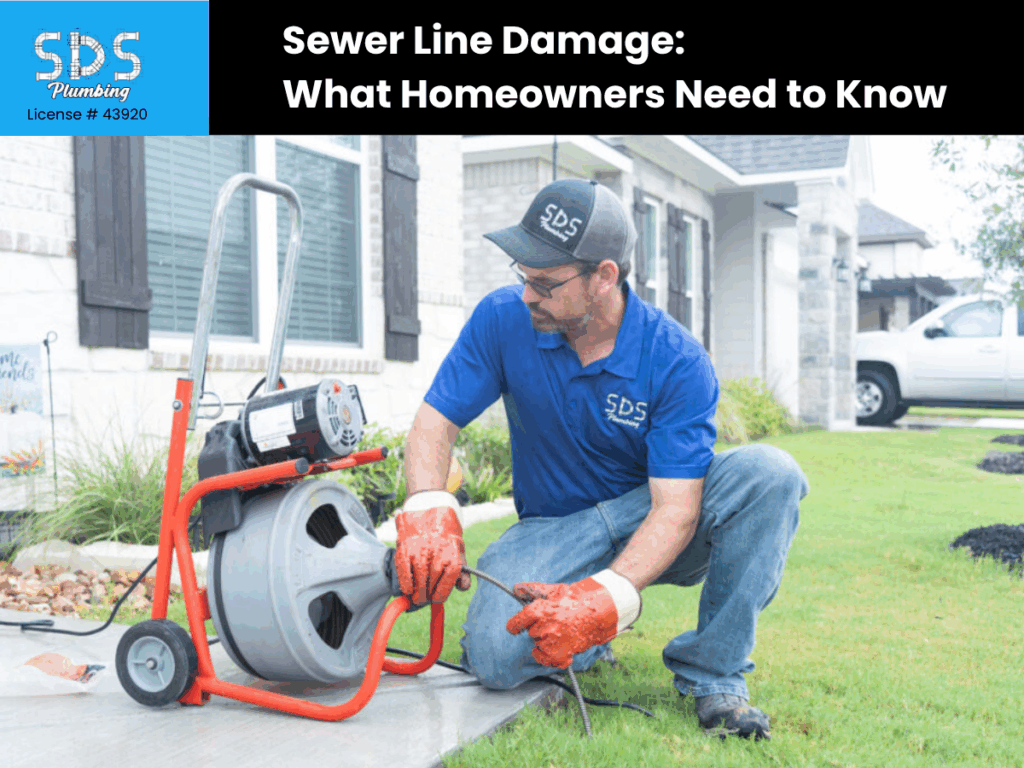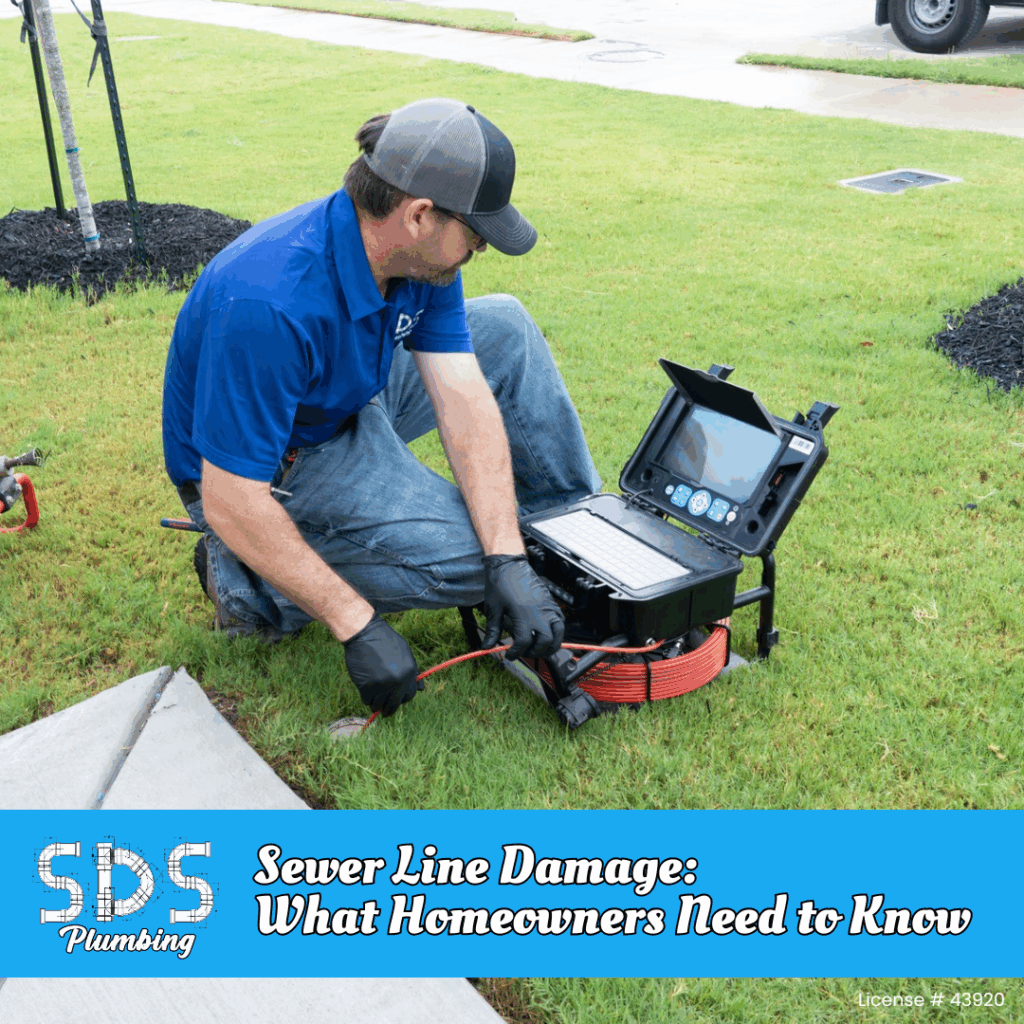
Your home’s sewer line isn’t something most people think about until something goes wrong. When sewer line damage occurs, it can lead to slow drains, smell of sewage, or even full sewage backups. Whether caused by tree roots, shifting surrounding soil, or a cracked sewer line, catching problems early is key to avoiding costly repairs.
At S.D.S. Plumbing, we’ve seen everything from minor leaks to major damage requiring sewer line replacement. Knowing the warning signs and getting help from a professional plumber as your first step can save you time, stress, and money.
Common Causes of Sewer Line Damage
- Tree Roots
One of the most common causes of a damaged sewer line is tree root intrusion. In older homes, where lines may be made of clay or cast iron instead of modern PVC pipes, roots can sneak into tiny cracks and expand. Over time, they block water flow and eventually cause a broken sewer line. - Shifting Soil or Ground Movement
The surrounding soil can shift due to rain, drought, or settling—especially in Texas. Even slight movement can misalign or fracture your plumbing system, leading to a cracked sewer line or even a full sewer problem. - Aging or Corroded Pipes
Pipes degrade over time. If your home is older, the main line may be reaching the end of its lifespan. Corrosion, cracks, or collapsing pipes can result in leaks, blockages, or major damage. - Improper Installation or Traffic Pressure
Bad installation or heavy vehicles over buried lines can stress and break them. In some cases, weak points in PVC pipes can lead to gradual leaks that go unnoticed until the foul smells become impossible to ignore.
Warning Signs of a Sewer Line Problem
Recognizing early signs of a sewer line problem can help you take action before major damage sets in:
- Slow drains throughout the house
- Gurgling noises in plumbing fixtures
- Foul odors or a smell of sewage around drains or your yard
- Wet or soft spots in the yard near the exact location of the main line
- Foul smells coming from basement drains or bathrooms
- Low or inconsistent water flow in multiple fixtures
- Signs of a collapsed sewer line, such as repeated blockages or visible pooling
Why Sewer Line Damage Is More Than an Inconvenience
A damaged sewer line isn’t just messy—it’s a health hazard. Leaks can let sewage seep into the surrounding soil, releasing bacteria and contaminants into your yard. Indoors, excess moisture can cause mold growth, structural damage, and strong foul smells that don’t go away. And the longer it’s left alone, the more likely it is to turn into a major problem that could require sewer line replacement.

How Plumbers Diagnose Sewer Line Problems
The first step is a thorough inspection. At S.D.S. Plumbing, we use sewer camera inspections to find the exact location of the issue without unnecessary digging. This allows us to:
- Identify whether it’s a clog or a broken sewer line
- Pinpoint tree root intrusion or cracked sewer line sections
- Evaluate pipe condition (older clay vs. PVC pipes)
- Recommend the right sewer line repair or sewer line replacement plan
Accurate diagnosis means a faster fix and less further damage to your plumbing system.
Repair & Replacement Options for Sewer Line Damage
Every sewer system is different, so solutions vary depending on the problem.
- Pipe Lining
For a cracked sewer line or small leaks, pipe lining creates a new pipe inside the old one without full excavation. This is ideal when the line is mostly intact but needs reinforcement.
- Sewer Line Replacement
If there’s major damage, like signs of a collapsed sewer line, sewer line replacement may be necessary. This involves removing the damaged sewer line and installing a new pipe, often using durable PVC pipes designed to last decades.
- Tree Root Removal
For tree root intrusion, specialized cutting tools remove roots and clear the pipe. Preventive steps can then be taken to keep roots from returning.
Preventive Maintenance Tips to Avoid Sewer Problems
Preventing issues is always cheaper than dealing with costly repairs. Preventive maintenance can extend the life of your home’s sewer line and prevent unexpected sewage backups:
- Schedule regular inspections, especially in older homes
- Avoid planting large trees near your main line to reduce tree root intrusion
- Watch for slow drains or foul odors—they’re early warning signs
- Don’t flush grease, wipes, or anything that can build up in pipes
- Consider pipe lining early rather than waiting for major damage
A little proactive care goes a long way toward keeping your plumbing system in good shape.
Why You Should Act Quickly
When there’s a sewer problem, waiting almost always makes it worse. What starts as a small crack in your sewer line can turn into a serious problem—and even major damage—if ignored. Acting fast protects your home, your yard, and your wallet.
And because foul odors, smell of sewage, and slow drains are not just annoyances but signs of a health hazard, it’s best to get help at the first sign of trouble.
FAQs
What’s the biggest cause of sewer line damage?
The top culprits are tree roots, aging pipes in older homes, and shifting surrounding soil. Roots are especially destructive when they find small cracks to grow through.
How do I know if I need sewer line replacement?
If your sewer line problem involves a collapsed pipe, repeated backups, or extensive corrosion, replacement may be the best option. A professional plumber can find the exact location of the issue and advise next steps.
Are sewer problems dangerous?
Yes. Leaks can create a health hazard, causing mold growth, soil contamination, and lingering foul smells. Prompt sewer line repair or replacement helps keep your home safe.
What kind of pipes are used for sewer line replacement?
Most modern replacements use PVC pipes, which are durable, resistant to corrosion, and last for decades with proper preventive maintenance.
How often should I get my sewer line inspected?
Regular inspections are a good idea, especially for older homes or properties with large trees nearby. Annual or biannual checks can prevent major damage.
Is sewer line damage fixable without digging up my yard?
In many cases, yes. Pipe lining can repair a damaged sewer line internally, saving time, cost, and mess.

Final Thoughts
A damaged sewer line is a serious problem, but it doesn’t have to turn into a crisis. Whether it’s tree root intrusion, foul smells, or signs of a collapsed sewer line, early action can prevent further damage and costly repairs.
We use modern tools and proven methods to find the exact location of the problem and fix it fast—whether through sewer line repair, pipe lining, or sewer line replacement.
Contact S.D.S. Plumbing today to schedule your regular inspection or repair. Protect your plumbing system, improve water flow, and keep your home free from the smell of sewage and major sewer headaches.





